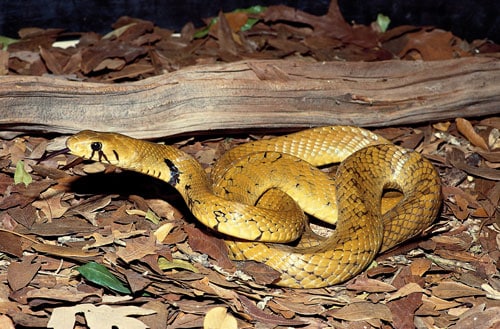Description:
This powerful, large, active, diurnal snake likes to climb and move stuff around. To house an adult (3 feet and up), start with a roomy, front-opening enclosure, measuring at least 4 feet long, 4 feet wide and 18 inches tall. Of course, the bigger, the better, especially, if housing two of these at a time. I use cyprus bark as a substrate. It holds humidity well and does not easily mold. Set up a hot spot of about 85 to 90 degrees Fahrenheit using a heat pad at one end of the enclosure. The rest of the cage can be maintained at about 75 to 80 degrees. Put a water bowl large enough for the snake to soak in at one end of the cage. They like to poop in their water, so be prepared to change it daily. Near that same end, place a hide large enough for all inhabitants to comfortably curl inside. Put similar hide at the hot end. Sturdy branches can be added to the enclosure, as cribos do enjoy climbing from time to time. Smaller decorations will just be pushed aside by these active movers and are therefore are usually useless. Maintain the humidity at about 70 percent by either spraying the substrate or by the use of a reptile fogger or mister set on a timer. No lighting is required, but it can be used to better view your snake. n the wild, they’ll eat mammals, birds and just about any amphibian or reptile. They don’t constrict, but instead grab the food and swallow it live. In captivity, they do very well on mice, for smaller individuals, and up to jumbo rats for the big boys. Fresh imports will sometimes resist feeding on pre-killed prey, but eventually, they will accept pre-killed rodents of an appropriate size. They do tend to have a feeding response, so feeding them in a separate enclosure is recommended. One appropriate-sized rodent once a week or more will satisfy the quick metabolism of this beast. For the most part, they are field collected and imported. They are usually 4 feet and up in size, and are quick to bite. They may pounce on you several times before you can react. Then again, sometimes (not often) you’ll be lucky enough to purchase a very mellow individual that will just let you pick it up with no problem. Most tame down after a period of time and go on to make great pets. Never put one in front of your face, though. Captive breeding is taking place but not as fast as I’d like to see it happen. Captive-bred babies are in high demand because of their ease in feeding and because they are normally a bit more mellow when handled (but not always). There are no morphs that I’m aware of. Not usually found in normal pet stores, but you can come across them at reptile specialty stores, reptile shows and over the Internet. Big and fast. Known for being aggressive, they are more suited for experienced snakekeepers because of their speed, cage space requirements and sometimes problematic feeding when first acquired. Buy captive bred if you are able.
Habitat:
Tropical lowland and upland forests, and dry upland forests from sea level to about 6,000 feet in elevation
Range:
Central America
Scientific Name: Drymarchon melanurus
Species Group:
Family: Colubridae
Size: 6 to 8 feet
Level: advanced
Weight:
Dangerous: No


